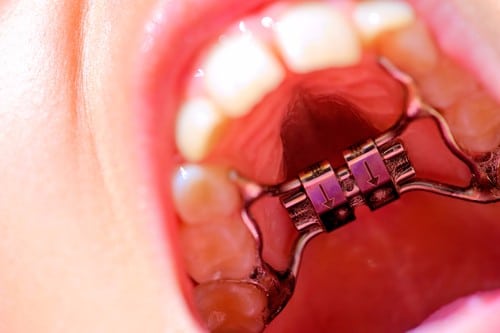Ideally, our upper and lower jaws would be both even in width and just wide enough to accommodate all 32 of our teeth. For most of us, though, either or both of our jawbones happen to be too narrow, and this can pose a problem during childhood and adolescence as our adult teeth grow in. Expanding the jawbone through precise and long-term orthodontic treatments and devices is the most efficient way to create this additional space. To learn more about upper jaw expansion also known as palatal expansion, check out orthodontist Dr. Andrew J. Dusel’s video below.
Download Our Free Orthodontic Care Guide
Watch This Video To Learn About Upper Jaw Expansion for Orthodontic Correction
In diagnosing a new case, we measure X-rays. These X-rays include a view from the front. This in turn enables us to measure the relative widths of the two jaws as they relate to each other and to the head. We measure the width of the patient’s jaws relative to her or his head size. If the jaws are skeletally narrow, we know we need to widen the upper jaw skeletally.
We recognize this when we see that the patient has a posterior cross bite. If a patient’s upper jaw is biting on the inside of the lower, he or she likely needs a skeletal expander. We always measure on the X-ray to clearly determine how narrow that patient’s jawbone is and how much upper jaw expansion is needed. If the bone is not skeletally narrow, but it appears that the teeth are dense—that is, if they look as though they tip in toward the roof of the mouth or toward the tongue—we use a dental expander to push the teeth into a better position. If teeth are crowded, we first try to create space by using a palatal expander, and straighten those teeth with braces later.
This allows our patients to avoid unnecessary surgery as the palatal expander may be enough to create sufficient room for the patients permanent teeth. Once the palatal expander has had time to expand the upper jaw, we will likely recommend braces at that point to help shift the teeth into their proper position.
The younger we are able to see patients to identify their need for a palatal expander, the better. Oftentimes with adult patients, if the condition has gone undiagnosed and untreated for an extended period of time, surgical orthodontics may be required to get the desired result. This is why we always stress the importance of early orthodontic treatment and offer free screenings for children to help identify the issues early while they can be treated in a much less invasive way.
Do you have questions about upper jaw expansion or how palatal expanders work? Want to learn how upper jaw expansion can benefit you or your loved ones? Contact our office to schedule a free screening today and let us help you get the answers you need to make an informed decision about your oral health. We have five convenient offices throughout Western New York and welcome the opportunity to serve you and your family. Contact us today.
Download Our Free Orthodontic Care Guide

